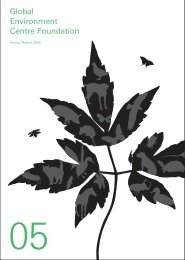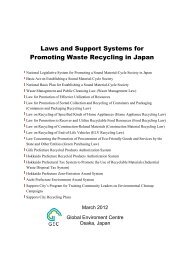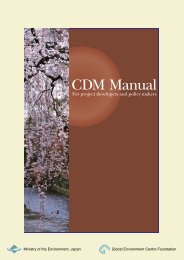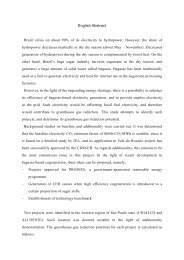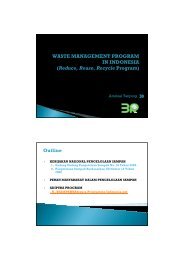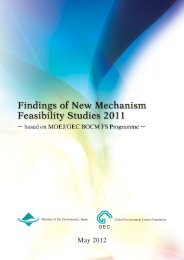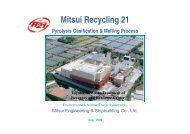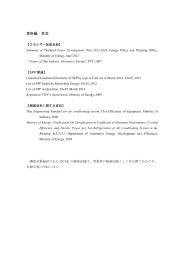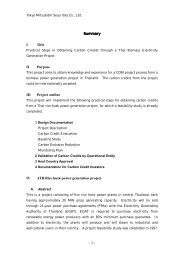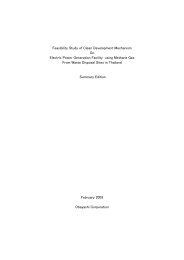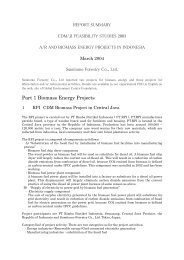PDF File - GEC
PDF File - GEC
PDF File - GEC
Create successful ePaper yourself
Turn your PDF publications into a flip-book with our unique Google optimized e-Paper software.
Title and Version<br />
Number<br />
2. Combined tool<br />
to identify the<br />
baseline scenario<br />
and demonstrate<br />
additionality in<br />
A/R CDM project<br />
activities (CT-AR)<br />
– Version 1 [EB35,<br />
Annex 19]<br />
3. Calculation of<br />
the number of<br />
sample plots for<br />
measurements<br />
within A/R CDM<br />
project activities<br />
– Version 1 [EB31,<br />
Annex 15]<br />
4. Tool for testing<br />
significance of<br />
GHG emissions in<br />
A/R CDM project<br />
activities– Version<br />
1 [EB31, Annex<br />
16]<br />
5. Estimation of<br />
GHG emissions<br />
related to fossil<br />
fuel combustion<br />
in A/R CDM<br />
project activities<br />
– Version 1 [EB33,<br />
Annex 14]<br />
Scope<br />
Applicability<br />
Parameter(s) to<br />
be determined<br />
Scope<br />
Applicability<br />
Parameter(s) to<br />
be determined<br />
Scope<br />
Applicability<br />
Parameter(s) to<br />
be determined<br />
Scope and<br />
applicability<br />
Parameter(s) to<br />
be determined<br />
Scope, Applicability and Parameters<br />
• This tool provides a general framework and a step-wise approach to identify<br />
the baseline scenario and simultaneously demonstrates additionality in A/R<br />
CDM project activities.<br />
• Application of this tool allows for transparent identification of baseline<br />
scenario which further allows for conservative establishing of baseline net<br />
greenhouse gas removals by sinks for a proposed afforestation or reforestation<br />
project under the CDM.<br />
• Project participants proposing new baseline methodologies may incorporate<br />
this tool in their proposal. Project participants may also propose other<br />
approaches for identification of the baseline scenario and the demonstration<br />
of additionality to the EB for its consideration.<br />
• In validating the application of this tool, DOEs should assess credibility of<br />
all data, rationales, assumptions, justifications and documentation provided<br />
by project participants to support the selection of the baseline and<br />
demonstration of additionality.<br />
Procedure: Project participants shall apply the following five steps:<br />
• STEP 0. Preliminary screening based on the starting date of the A/R project<br />
activity;<br />
• STEP 1. Identification of alternative scenarios;<br />
• STEP 2. Barrier analysis;<br />
• STEP 3. Investment analysis (if needed);<br />
• STEP 4. Common practice analysis.<br />
• Forestation of the land within the proposed project boundary performed with<br />
or without being registered as the A/R CDM project activity shall not lead to<br />
violation of any applicable law even if the law is not enforced.<br />
• This tool is not applicable to small scale afforestation and reforestation project<br />
activities.<br />
This procedure does not use its own parameters.<br />
This tool is applicable if sample plots are used for monitoring purposes. The tool<br />
estimates the number of permanent sample plots needed for monitoring changes<br />
in carbon pools at a desired precision level. Permanent sample plots are preferred<br />
when:<br />
• Measurements are to be made at specific time intervals;<br />
• High covariance is expected between observations at successive sampling<br />
events.<br />
• Variables under consideration are normally distributed or may be transformed<br />
into a normal distribution.<br />
This tool is applicable under the following condition:<br />
Normal distribution can be assumed when:<br />
• Many small (independent) effects contribute to each observation in an additive<br />
fashion.<br />
• Sample size (total number of permanent sample plots required) in the project<br />
area [n]<br />
• Sample size for stratum i [n i ]<br />
This tool facilitates the determination of which GHG emissions by sources,<br />
possible decreases in carbon pools, and leakage emissions are insignificant for<br />
a particular CDM A/R project activity. The sum of decreases in carbon pools and<br />
increases in emissions that may be neglected shall be less than 5% of the total<br />
decreases in carbon pools and increases in emissions, or less than 5% of net<br />
anthropogenic removals by sinks, whichever is lower.<br />
The tool shall be used in the application of an A/R CDM approved methodology<br />
to an A/R CDM project activity:<br />
• To determine which decreases in carbon pools, and increases in GHG emissions<br />
measured in CO 2 equivalents that result from the implementation of the A/R<br />
project activity, are insignificant and can be neglected.<br />
• To ensure that it is valid to neglect decreases in carbon pools and increases<br />
in GHG emissions by sources stated as being insignificant in the applicability<br />
conditions of an A/R CDM methodology.<br />
This procedure does not use its own parameters.<br />
This tool allows for estimating increase in GHG emissions (both project and<br />
leakage emissions) related to fossil fuel combustion in A/R CDM project activities.<br />
The sources of emissions are: vehicles (mobile sources, such as trucks, tractors,<br />
etc.) and mechanical equipments (e.g. portable equipment such as chain saws<br />
and stationary equipment such as, water pumps) required by the A/R CDM project<br />
activity.<br />
CO 2 emissions from fossil fuel combustion during the year y (tCO 2 ) [ET FC,y ]<br />
97



